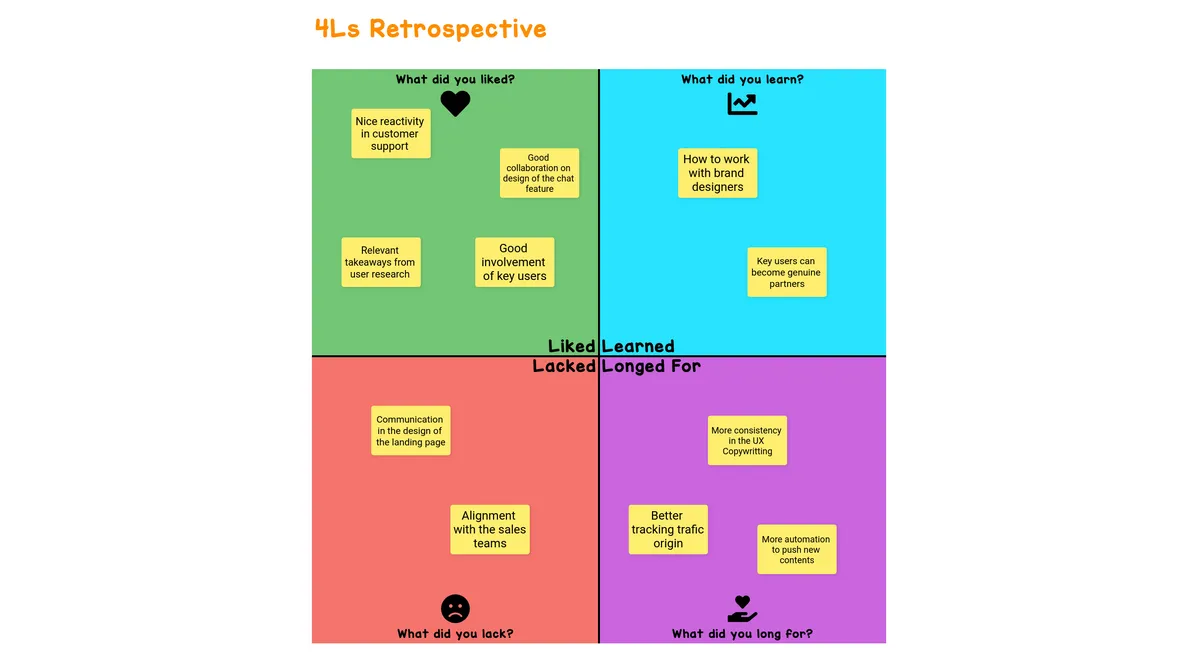What is the 4L’s Retrospective?
The 4L’s Retrospective offers a clear framework for helping individuals within Agile teams evaluate and assess the relative success of their contributions during a sprint by asking them to organize their ideas across four primary axes:
- Liked: What I liked during this sprint (i.e., what went well).
- Learned: What I learned during this sprint.
- Lacked: What I lacked in order to do my work effectively.
- Longed for: What I want for the next iteration.
How to run a 4L’s Retrospective
Step 1: Individual reflection
The facilitator should give participants five to ten minutes to jot down ideas on sticky notes for each of the four areas above. Each sticky note should represent only one idea.
Be sure to use “polling booth mode” to ensure participants don’t inadvertently influence each other with their ideas before it’s time to share.
Step 2: Commenting and reorganizing ideas
Have all participants take turns sharing what they wrote on their own sticky notes. It is recommended to share ideas in this order: Liked, Learned, Lacked, and Longed For.
While this is happening, the facilitator should organize similar ideas into groups to visually display when there are overlapping sentiments among the team.
Step 3: Proposal of areas for improvement
The facilitator should then give participants five to ten minutes to come up with ideas for improvement. Once the time is up, they should take turns sharing their ideas with the team.
Step 4: Selection of areas for improvement
Finally, the facilitator should invite participants to vote and select the most relevant ideas to pursue. The three ideas with the most votes will be incorporated into an action plan—with a “person in charge” appointed to each task to ensure execution and accountability.
Tips and advice from a seasoned Agile Coach
Amélie Aucomte, Agile Coach/Scrum Master at Infopro Digital, has led many retrospectives in the past. Here is her advice for getting the most out of them:
- The Lacked (“What I needed in order to do my work more efficiently”) and Longed For (“What I would like to achieve in the next sprint”) categories are intended to be complementary to one another. For this reason, it’s important for the facilitator to play a proactive role in identifying any commonalities or recurring themes that crop up while the team’s ideas are being shared. Why? Because the intersection of these two areas can oftentimes reveal a team member’s level of engagement (or lack thereof), thereby creating a new opportunity to reinforce team alignment and cohesion.
- Keep the retrospective as structured as possible and be sure to take time to present the agenda before getting started. This should include:
- General rules for participating in the ceremony;
- Overview of the output from the last retrospective;
- Brainstorming and generating new ideas;
- Using dot voting to drive team decision-making;
- Identifying new actions or initiatives for the next sprint.
- Remind participants about the purpose of this respective: To question the team’s processes and relationships in order to make them more effective. This relates directly to principle 12 of the Agile Manifesto: “At regular intervals, the team reflects on how to become more effective, then tunes and adjusts its behavior accordingly.”
- Be clear on the rules of engagement. This may include things like: giving everyone a chance to speak, not making any nominations, not passing any judgments, including only one idea per sticky note, adding initials to the sticky notes, etc.
- Start with an Ice Breaker to create a relaxed atmosphere that will be more conducive to open and thoughtful dialogue. End the ceremony by collecting feedback from participants, for example, via an Agile Return on Time Invested (ROTI) exercise.
- Create a space for all team members to be able to propose process improvements in order to prevent the same team members from dominating the exercise every time.
Suggested resources to learn more about the 4L’s Retrospective
- The article by Mary Gorman and Ellen Gottesdiener that introduces this retrospective theme: The 4L’s: A Retrospective Technique.
